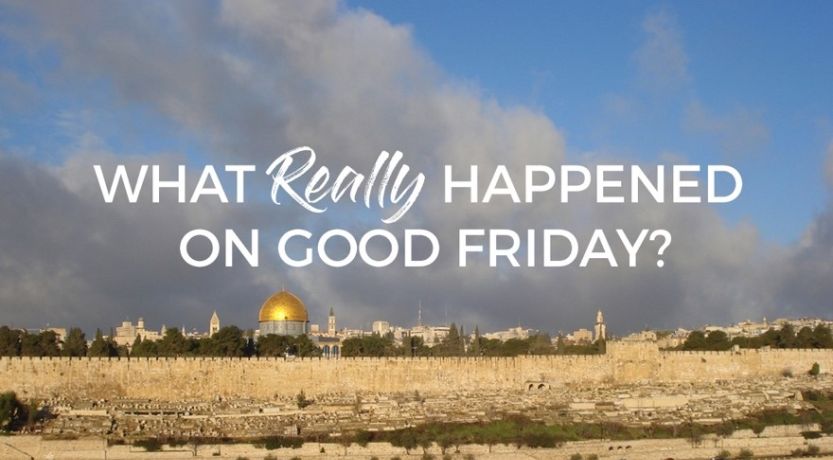What Really Happened on Good Friday?
Every year millions commemorate Good Friday on the Friday before Easter. It’s believed that Jesus was crucified and entombed on that Friday afternoon. But does the Bible teach that Jesus was crucified on Good Friday?

Good Friday is the traditional holiday supposedly honoring the day of Jesus Christ’s crucifixion. However, a concordance search will reveal that the term Good Friday is not found in the New Testament.
Some sources say it comes from “God’s Friday,” while others say it comes from the German Gute Freitag. It is referred to as “Holy Friday” in Romance languages and was called “Long Friday” by the Anglo-Saxons and is still referred to that way in modern Danish.
But do the four Gospel accounts designate Friday as the day Jesus died and was entombed? If not, then what did happen on that Friday?
Three days and three nights
Many people overlook the fact that Jesus gave only one sign that He was the Messiah and Son of God—what He called the “sign of the prophet Jonah.” He said, “For as Jonah was three days and three nights in the belly of the great fish, so will the Son of Man be three days and three nights in the heart of the earth” (Matthew 12:39-40).
Notice carefully: He said He would be buried in the earth for exactly three days and three nights (72 hours). This clear statement poses a challenge to the traditional teaching that Jesus died on the cross on Friday afternoon around 3 p.m., was placed in a sepulcher before the Sabbath began at sunset, and then was resurrected before sunrise on Sunday morning.
There’s no way His “sign of the prophet Jonah” could be fulfilled in that period of time. Count it out:
- Friday night (night 1).
- Saturday daytime (day 1).
- Saturday night (night 2).
- Sunday morning (day 2).
Of course, the above reckoning is generously counting sunrise on Sunday morning as a full day—which it isn’t. By this counting, at most you can get two days and two nights. There’s no way to squeeze another day or night in there.
The Bible says that “it is impossible for God to lie” (Hebrews 6:18). So, there has to be another explanation.
There were two Sabbaths that week
Jesus came to Jerusalem that week to observe the Passover (Matthew 26:18-19). Immediately following the Passover was the Feast of Unleavened Bread. This festival lasts seven days, and its first day and seventh day are annual Sabbath days—or high days (Leviticus 23:4-8).
When we understand that there were two Sabbaths observed in Jerusalem that week, understanding Jesus’ statement about “three days and three nights” becomes easier.
These two annual Sabbath days fall on different days of the week from year to year, and they are determined based on the Hebrew calendar.
When explaining the timing of the crucifixion and the resurrection, most of the Christian world ignores or overlooks the annual Sabbaths because they don’t celebrate these days.
As the saying goes, out of sight, out of mind.
When we understand that there were two Sabbaths observed in Jerusalem that week—an annual Sabbath and the weekly Sabbath—understanding Jesus’ statement about “three days and three nights” becomes easier.
To explore this further, read ““Three Days and Three Nights” From Good Friday to Easter Sunrise?”
Do Mark and Luke contradict each other?
There are two accounts in the Gospels that can seem to contradict each other if you don’t take into account that there were two Sabbaths that week.
In Mark 16:1 we read, “Now when the Sabbath was past [or over], Mary Magdalene, Mary the mother of James, and Salome bought spices, that they might come and anoint Him.” Notice carefully, they bought these spices after the Sabbath.
But in Luke 23:54-56 we read, “That day was the Preparation, and the Sabbath drew near. … Then they [the women] returned and prepared spices and fragrant oils. And they rested on the Sabbath according to the commandment.” Notice carefully, they prepared these spices before the Sabbath.
How could the women buy the spices after the Sabbath is past and prepare those spices and fragrant oils before the Sabbath? There is only one explanation. Mark was writing of the annual Sabbath being past, while Luke was writing about the weekly Sabbath being about to begin.
So what happened on the Friday of the crucifixion week?
The year that Jesus was crucified, the annual Sabbath of the first day of Unleavened Bread fell on Thursday. Since Jesus died prior to this annual Sabbath day, His crucifixion and death took place on Wednesday afternoon. He was buried hastily before the annual Sabbath began at sunset.
John’s Gospel backs this up with this key statement: “Therefore, because it was the Preparation Day, that the bodies should not remain on the cross on the Sabbath (for that Sabbath was a high day), the Jews asked Pilate that their legs might be broken, and that they might be taken away” (John 19:31).
Again, this “high day” Sabbath was an annual Sabbath—not the weekly Sabbath that always fell on Saturday.
Jesus was entombed right before sunset on Wednesday. If we count forward three days and three nights (or 72 hours), we discover exactly when He rose to life again: right before sunset on Saturday evening. This harmonizes perfectly with the Gospel accounts that the women visited the tomb very early on Sunday morning and found nobody there.
Jesus had already risen hours earlier!
So what happened on the Friday of that week? The answer is that Jesus’ body was in the tomb of Joseph of Arimathea for the second day since His death (Matthew 27:57-61).
At some point on that day—the day after they had kept the first holy day of Unleavened Bread—the women went to buy spices. They started to prepare those spices and fragrant oils to put on Jesus’ body, but had to stop and get back to their dwellings as the sun began to set and the beginning of the weekly Sabbath drew near.
There is no command in the Bible to commemorate that Friday.
What does this mean for us today?
Earlier in His ministry, Jesus spoke the following words to the Samaritan woman at Jacob’s well: “But the hour is coming, and now is, when the true worshipers will worship the Father in spirit and truth; for the Father is seeking such to worship Him. God is Spirit, and those who worship Him must worship in spirit and truth” (John 4:23-24).
Instead of worshipping God in “spirit and truth,” most churches today worship by following their own traditions—a human tendency that Jesus warned against (Mark 7:6-9).
The teaching of Good Friday as the day of the crucifixion is one of many traditions that contradict Scripture.
If you desire to worship God “in spirit and truth,” you may want to look into the festival days He created. To learn more about these days, visit “Passover and the Days of Unleavened Bread: Do You Know What They Mean?”
Date Posted: April 18, 2025



